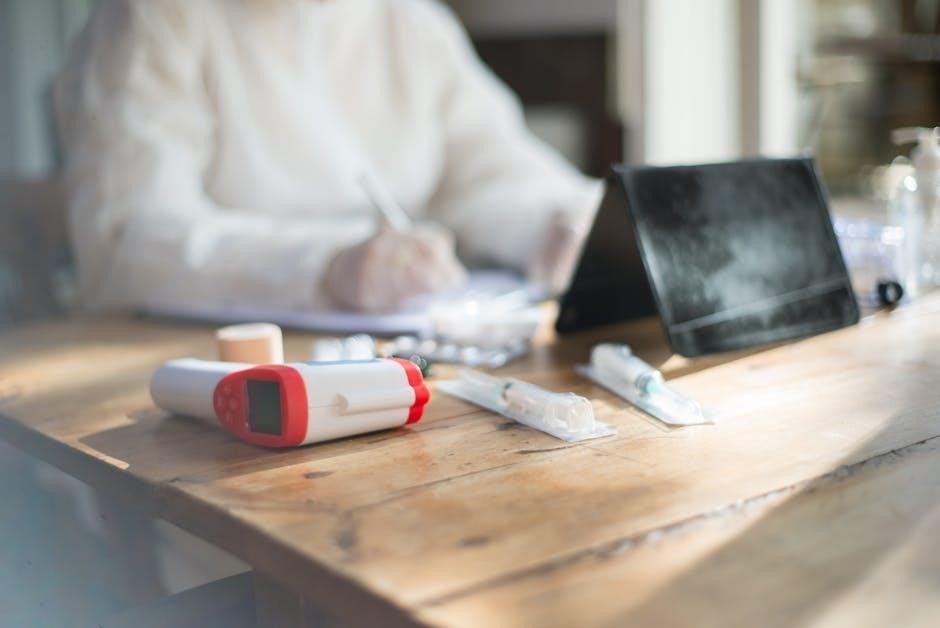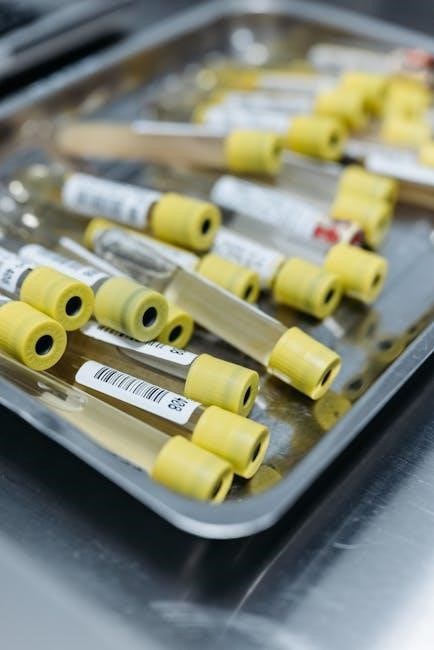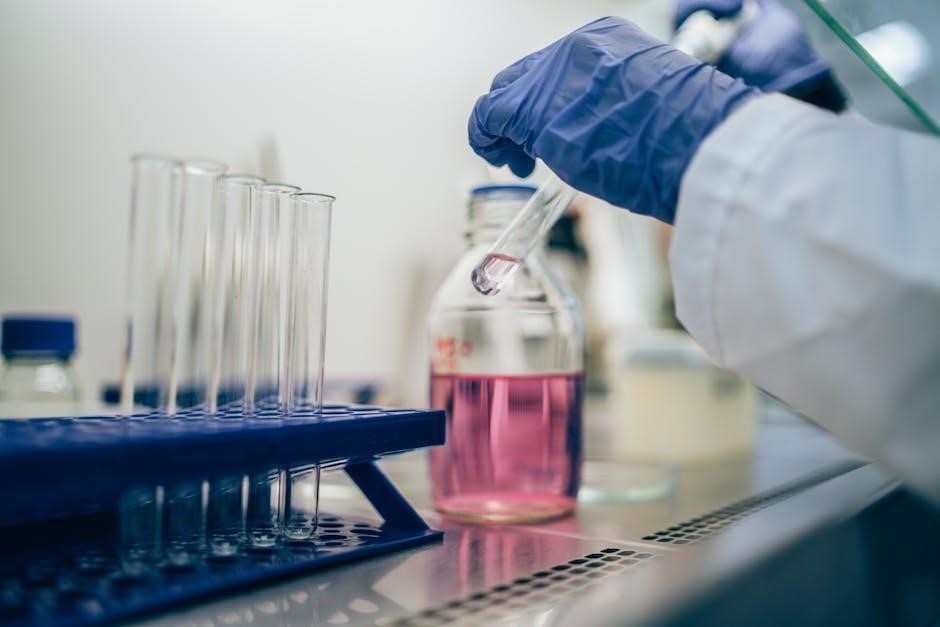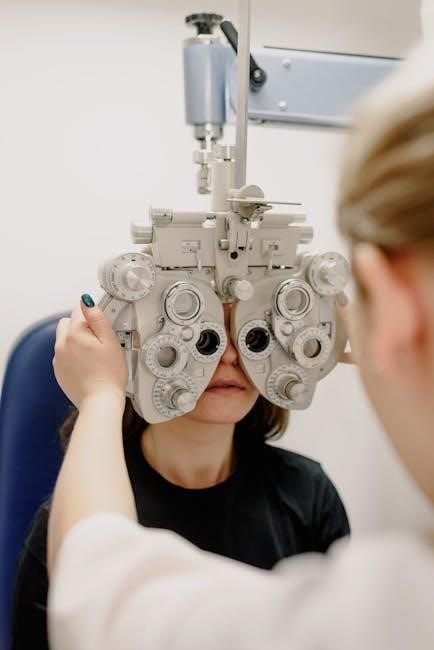Nitrogen leak testing is a critical process to ensure system integrity and safety across various industries․ This guide provides a comprehensive overview of the procedure, emphasizing precision and reliability․
1․1 Importance of Nitrogen Leak Testing
Nitrogen leak testing is essential for ensuring the integrity and reliability of systems in various industries․ It helps detect even the smallest leaks, preventing potential failures, safety hazards, and contamination․ By identifying and addressing leaks early, it minimizes downtime, reduces maintenance costs, and extends equipment lifespan․ This method is particularly critical in high-pressure or vacuum systems, where even minor breaches can lead to significant issues․ Regular nitrogen leak testing also ensures compliance with industry standards and enhances overall system performance, making it a cornerstone of quality control and operational safety in sectors like aerospace, automotive, and industrial manufacturing․
1․2 Brief Overview of the Procedure
Nitrogen leak testing involves pressurizing a system with nitrogen gas to detect leaks․ The process begins with system preparation, followed by pressurization and stabilization․ Leak detection methods, such as bubble solutions, ultrasonic sensors, or specialized detectors, are then applied․ The procedure ensures precise identification of leaks, allowing for prompt repairs․ This method is non-destructive and environmentally safe, making it ideal for various industrial applications․ By following standardized steps, technicians can ensure accurate results, maintaining system reliability and safety․ Proper execution of this procedure is vital for preventing failures and ensuring optimal performance in critical systems․

Equipment and Materials Required
The nitrogen leak test requires specific tools, gases, and materials to ensure accurate and safe detection of leaks in industrial systems․
2․1 List of Essential Tools and Instruments
The nitrogen leak test requires a pressure gauge, nitrogen gas supply, leak detection instruments, valves, fittings, tubing, and a vacuum pump․ Additional tools include safety goggles and gloves․
2․2 Safety Gear and Protective Equipment
Safety goggles, gloves, and a gas mask are essential to protect against nitrogen exposure․ Steel-toe boots and insulated gloves prevent injuries from heavy equipment․ A fire extinguisher should be nearby․ Ensure all safety gear is in good condition and easily accessible during the test․

Safety Precautions and Guidelines
Always ensure proper ventilation when handling nitrogen to prevent asphyxiation risks․ Personnel must be trained in emergency procedures and equipment operation․ Follow industry standards strictly to minimize hazards and ensure compliance․ Keep emergency contact information readily available․ Regular safety audits are essential to maintain a secure testing environment․
3․1 Handling Nitrogen Safely
Handling nitrogen requires careful attention to safety protocols․ Store nitrogen cylinders upright in well-ventilated areas, away from heat sources and flammable materials․ Always use compatible hoses and fittings to prevent gas leaks․ Wear appropriate personal protective equipment, including safety goggles and gloves, when handling high-pressure systems․ Ensure cylinders are securely fastened to prevent tipping․ Never inhale nitrogen directly, as it can displace oxygen in the air․ Follow proper valve operation procedures and purge lines before connecting or disconnecting․ Keep emergency shutdown valves accessible and maintain fire extinguishers nearby․ Regularly inspect equipment for wear and tear to prevent accidents․
3․2 Emergency Procedures in Case of a Leak
In the event of a nitrogen leak, prioritize safety and follow established protocols․ Evacuate the area immediately and alert nearby personnel․ Shut off the nitrogen supply valve to minimize gas release․ Open windows and doors to ventilate the space, but only if it is safe to do so․ Use oxygen detection equipment to monitor air quality before re-entry․ Contact emergency services or your facility’s safety team for assistance․ Avoid sparks or ignition sources, as nitrogen-rich environments can be hazardous․ Document the incident and conduct a thorough investigation to prevent future occurrences․ Ensure all safety measures are in place before resuming operations․

Step-by-Step Nitrogen Leak Test Procedure
This section outlines the systematic approach to conducting nitrogen leak tests, including system preparation, pressurization, and leak detection, ensuring accurate and reliable results․
4․1 Preparing the System for Testing
Preparing the system for nitrogen leak testing is essential to ensure accurate results․ Begin by cleaning the system to remove contaminants and debris․ Inspect all connections, valves, and components for damage or wear․ Isolate the system from external influences and ensure all safety valves are functional․ Set up the system to operate within its designed pressure range․ Purge the system with nitrogen to eliminate residual gases․ Finally, install test ports and connect necessary instruments․ Proper preparation minimizes errors and ensures the test reflects the system’s true integrity․
- Clean the system thoroughly․
- Inspect all components for damage․
- Isolate the system and purge with nitrogen․
- Install test ports and connect instruments․
4․2 Pressurizing the System with Nitrogen
Pressurizing the system with nitrogen is a critical step in the leak test procedure․ Begin by filling a nitrogen tank to the required pressure․ Connect the tank to the system via approved hoses and fittings․ Gradually pressurize the system to the specified test pressure, ensuring no sudden surges․ Monitor the pressure gauge to confirm stability․ Allow the system to stabilize for a short period before proceeding․ This step ensures the system is ready for leak detection and helps identify any potential weak points under pressure․
- Fill the nitrogen tank to the required pressure․
- Connect the tank to the system using approved fittings․
- Gradually pressurize the system to test pressure․
- Monitor and stabilize the system pressure․
4․3 Detecting Leaks Using Appropriate Methods
Detecting leaks is a crucial phase in nitrogen leak testing․ Common methods include bubble testing, electronic gas detectors, and pressure drop analysis․ For bubble testing, apply a soapy solution to connections; bubbles indicate leaks․ Electronic detectors sense nitrogen escaping, providing precise leak location․ Pressure drop tests involve sealing the system and monitoring pressure changes over time․ Choose the method based on system size, sensitivity requirements, and test conditions․ Ensure all connections and joints are inspected thoroughly․ Accurate detection ensures system reliability and safety․
- Bubble testing: Apply soapy solution to detect escaping gas․
- Electronic detectors: Use sensors for precise leak location․
- Pressure drop analysis: Monitor pressure changes in a sealed system․

Interpreting Test Results
Interpreting test results involves analyzing leak rates, pressure changes, and system performance․ Compare data to established thresholds to determine pass/fail status and identify anomalies for further investigation․
- Analyze leak rates against acceptable limits․
- Compare pressure changes to expected values․
- Document findings for future reference or repairs․
5․1 Understanding Leak Rates and Thresholds
Leak rates and thresholds are critical in determining system integrity during nitrogen leak testing․ A leak rate measures the rate at which nitrogen escapes from a system, typically expressed in units like liters per second or atmospheres per minute․ Thresholds are predefined acceptable limits for these rates, varying by industry, application, and system specifications․ Understanding these values ensures precise evaluation of test outcomes․ If leak rates exceed thresholds, it indicates a potential issue requiring immediate attention․ Accurate interpretation is essential for maintaining safety, efficiency, and compliance with quality standards․ Proper documentation of these measurements ensures traceability and informed decision-making for repairs or further testing․
- Measure and compare leak rates against established thresholds․
- Identify acceptable limits based on industry or system requirements․
- Document all measurements for analysis and compliance purposes․
5․2 Identifying and Addressing Potential Issues
Identifying and addressing potential issues is crucial for ensuring system reliability after nitrogen leak testing․ Common problems include faulty seals, damaged gaskets, or improperly tightened connections․ Leak detection methods like bubble testing or gas sensors help pinpoint issues․ Once identified, addressing the problem involves tightening connections, replacing defective components, or re-sealing joints․ Documenting the root cause and corrective actions ensures long-term system integrity․ Regular follow-up testing verifies repairs and prevents recurring issues, maintaining operational efficiency and safety standards․
- Inspect system components for visible signs of leaks or damage․
- Replace or repair faulty parts to meet leak rate thresholds․
- Conduct repeat testing to confirm issue resolution․
Calibration and Maintenance of Equipment
Regular calibration and maintenance of leak detection equipment ensure accuracy and reliability in nitrogen leak testing․ Proper upkeep prevents errors, extends equipment life, and guarantees consistent test results․
6․1 Calibrating Leak Detection Instruments
Calibrating leak detection instruments is essential for ensuring accurate and reliable test results․ Use certified reference leaks or gases to verify instrument sensitivity and response․ Regular calibration minimizes measurement errors and ensures compliance with industry standards․ Always follow the manufacturer’s guidelines for calibration procedures and intervals․ Proper calibration also extends the lifespan of equipment and maintains its performance over time․ Keep records of calibration dates and results for audit purposes․ Consistent calibration ensures precise leak detection, critical for system safety and efficiency in industrial applications․
6․2 Regular Maintenance for Optimal Performance
Regular maintenance is crucial to ensure the longevity and efficiency of leak detection equipment․ Inspect seals, hoses, and connections for wear or damage, replacing them as needed․ Clean sensors and components to prevent contamination․ Check gas lines for blockages or leaks and ensure all fittings are secure․ Perform routine checks on power sources and electrical connections to avoid malfunctions․ Follow manufacturer guidelines for servicing and replacing parts․ A well-maintained system reduces downtime and ensures accurate test results․ Schedule maintenance intervals based on usage and environmental conditions to uphold performance standards․ Proper care extends equipment life and maintains reliability in nitrogen leak testing applications․

Documentation and Reporting
Accurate documentation and reporting are essential for maintaining traceability and accountability․ Ensure all test results are recorded, and reports are generated to meet industry standards and compliance requirements․
7․1 Recording Test Data and Outcomes
Recording test data and outcomes is a vital step in nitrogen leak testing․ Ensure all measurements, pressure levels, and times are documented accurately․ Use standardized forms or digital tools to log results, including pass/fail statuses․ Store data securely for future reference and compliance․ Include details like system specifications, test conditions, and any anomalies observed․ Maintain thorough records to facilitate traceability and accountability․ Regularly review and update documentation to reflect changes or retests․ Proper data recording ensures transparency and supports quality control measures, making it easier to address potential issues and improve testing processes over time․
7․2 Generating a Comprehensive Test Report
Generating a comprehensive test report is essential for documenting nitrogen leak test results․ Include test objectives, procedures, data, and outcomes․ Clearly state pass/fail criteria and any deviations․ Provide detailed annotations for anomalies or failures․ Append visual aids like charts or images if necessary․ Ensure the report includes system details, test conditions, and operator information․ Review and validate the report for accuracy and completeness․ Submit the final document in a standardized format, ensuring compliance with industry standards․ Archive the report securely for future reference and compliance audits․ A well-structured report enhances traceability, accountability, and quality control in nitrogen leak testing processes․
Nitrogen leak testing is a vital process ensuring system reliability and safety․ Adhering to proper protocols guarantees accurate results, minimizing risks and enhancing operational efficiency across industries․
8․1 Summary of Key Takeaways
Nitrogen leak testing is a precise method to ensure system integrity and safety․ Key steps include proper preparation, controlled pressurization, and accurate leak detection․ Safety protocols are crucial to prevent hazards․ Regular calibration of equipment ensures reliable results, while detailed documentation aids in tracking and compliance․ Understanding leak rates and addressing issues promptly minimizes downtime and enhances performance․ By following established guidelines, professionals can maintain system reliability and operational efficiency across industries like aerospace, automotive, and industrial manufacturing․ Adhering to these principles is essential for achieving consistent and accurate test outcomes․
8․2 Importance of Regular Testing
Regular nitrogen leak testing is essential for maintaining system integrity and operational efficiency․ It helps identify potential failures early, ensuring safety and minimizing downtime․ Consistent testing prevents gas leaks, which can pose environmental and financial risks․ By adhering to a scheduled testing regime, industries can uphold quality standards, reduce maintenance costs, and ensure compliance with safety regulations․ Regular testing also builds confidence in system performance, fostering reliability across applications․ Ultimately, it is a proactive approach to safeguarding equipment, personnel, and the environment while optimizing overall productivity and efficiency․